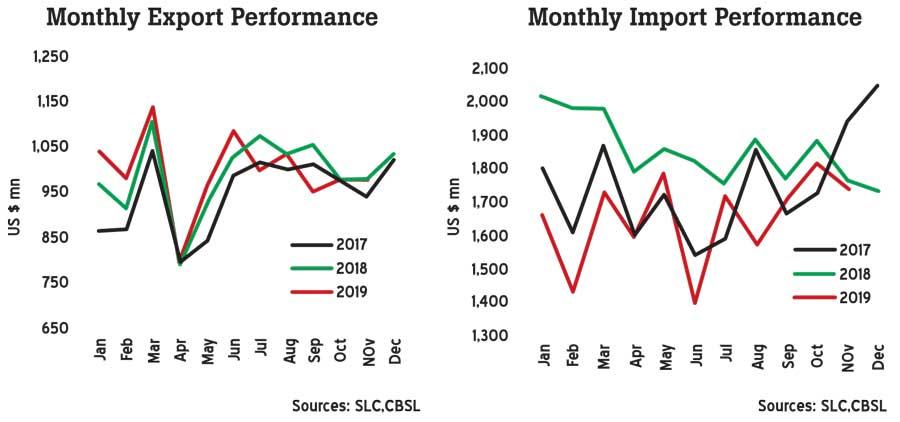20 Jan 2020 - {{hitsCtrl.values.hits}}

Sri Lanka’s trade deficit narrowed in November supported by lower import of vehicle and fuel imports, although export earnings declined marginally, the external trade data released by the Central Bank showed.
Export earnings fell for the fifth consecutive month by 0.1 percent year-on-year (YoY) to US$ 4 979 million with all major sub sectors recording declines. The import expenditure also contracted for the 13th consecutive month by 1.3 percent YoY to US$ 1.7 billion driven by lower intermediate goods imports.
Accordingly, the deficit contracted marginally by US$ 23 million to US$ 762 million in November compared to year ago.
Meanwhile, the cumulative trade deficit for the first eleven months of 2019 contracted to US$ 7.2 billion from US$ 9.6 billion in the corresponding period of 2018, driven by import restrictions on personal vehicles and gold as well as a marginal increase in exports.
The decline in gold and personal vehicle imports has contributed to nearly half of the contraction in the trade deficit during the period.
The import of intermediate goods declined by 7.6 percent YoY in November, mainly due to lower expenditure on fuel, owing to both lower import volumes and international prices. The import expenditure on crude oil, refined petroleum and coal fell by 20.8 percent YoY to US$ 319.6 million in November.
The import expenditure on non-food consumer goods, driven by lower personal vehicle imports, continued its downward trend in November as well, recording a 23 percent YoY decline to US$ 80.7 million.
However, the CB noted that reflecting the impact of the resumption of personal motor vehicle imports under concessionary permits, expenditure on personal motor vehicle imports remained at a relatively high level, on average, since July 2019, compared to values recorded during the first half of 2019.
Meanwhile, the import of home appliances, household and furniture items in the non-food consumer goods category expanded rapidly by 29.2 percent and 15.8 percent YoY respectively during the month.
The expenditure on consumer food items also expanded by 26.7 percent YoY to reach US$ 140.7 million driven by imports such as vegetables (mainly onions), sugar and dairy products due to both higher import volumes and prices.
Meanwhile, expenditure on investment goods import picked up by 15.9 percent YoY to US$ 377.8 million in November 2019.
“Accordingly, expenditure on machinery and equipment increased driven by medical and laboratory equipment, while expenditure on transport equipment increased with higher expenditure incurred on railway engines and carriages. In addition, expenditure on building material increased due to higher imports of articles of iron and steel related to bridges and bridge sections,” the CB stated.
In addition, expenditure on cement clinkers, categorised under mineral products also increased substantially in November 2019.
Meanwhile, lower earnings from agricultural products, except for coconut, vegetables and unmanufactured tobacco weighed on total export earnings mainly due to lower export prices while industrial exports remained unchanged during the month.
Textiles and the garments acted as the catalyst for the overall earnings from exports, as the earnings from this category rose 3.2 percent YoY in the month to US$ 448.1 million supported by higher demand for garment exports from the EU and non-traditional markets.
Earnings from tea exports declined by 1.7 percent YoY to US$ 101.5 million in the month as a result of lower average export prices in line with the fall in international tea market prices, although export volumes of tea continued to increase.
The earnings from tourism were estimated at US$ 332 million in November 2019, marginally down from US$ 367 million recorded in November 2018.
The decline in tourist arrivals eased to 9.5 percent YoY in November 2019, compared to the drop of 22.5 percent in October and 27.2 percent in September 2019 in the aftermath of deadly Easter Sunday attacks. In cumulative terms, earnings from tourism were provisionally estimated at US$ 3.1 billion during the first eleven months of 2019, below US$ 3.9 billion recorded during the corresponding period of 2018.
Meanwhile, workers’ remittances declined by 7.2 percent YoY to US$ 515 million in November. On a cumulative basis, workers’ remittances declined by 5.9 percent to US$ 6.1 billion during the first eleven months of 2019, compared to the corresponding period of 2018.
16 Nov 2024 29 minute ago
15 Nov 2024 15 Nov 2024
15 Nov 2024 15 Nov 2024
15 Nov 2024 15 Nov 2024
15 Nov 2024 15 Nov 2024